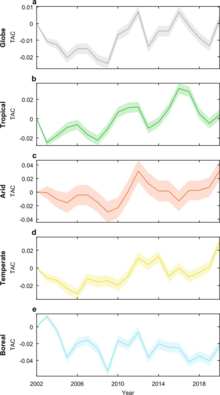Critical transition
Critical transitions are abrupt shifts in the state of
Early-warning signals
Critical slow down



Significant efforts have been made to identify early-warning signals of critical transitions.[14][15][16][17][18][19][20][21] Systems approaching a bifurcation point show a characteristic behaviour called critical slowing down leading to an increasingly slow recovery from perturbations. This, in turn, may lead to an increase in (spatial or temporal) autocorrelation and variance, while variance spectra tend to lower frequencies,[15][18][19] and the 'direction of critical slowing down' in a system's state space may be indicative of a system's future state when delayed negative feedbacks leading to oscillatory or other complex dynamics are weak.[12] Researchers have explored early-warning signals in lakes, climate dynamics, the Amazon rainforest,[22] forests worldwide,[13] food webs, dry-land transitions and epilepsy attacks.[15]
Examples
Studies show that more than three-quarters of Amazon rainforest has been losing resilience since the early 2000s as measured by CSD[22] and that tropical, arid and temperate forests are substantially losing resilience.[13] It has been proposed that a loss of resilience in forests "can be detected from the increased temporal autocorrelation (TAC) in the state of the system, reflecting a decline in recovery rates due to the critical slowing down (CSD) of system processes that occur at thresholds".[13]
Flickering
The above approach (looking for critical slow down) is how most researchers assess if a critical transition is imminent. However, in highly stochastic (random) systems, alternative basins of attraction will be reached well before bifurcation points are reached.[23] Perturbations might therefore cause the system to 'flicker' between the basins of attraction.
Examples
This idea has gained considerable interest in the last few years, somewhat entering the mainstream.[24]
The idea has been applied widely, to studies of ecological resilience[25] (such as eutrophication of a lake
See also
- Tipping points in the climate system
- Deforestation and climate change
- Ecological resilience
- Ecological threshold
- Ecosystem collapse
- Cascade effect (ecology)
- Percolation theory
References
- S2CID 8001853.
- ISBN 978-0691122045.
- S2CID 4001553.
- S2CID 4005516.
- PMID 24324144.
- ISSN 0958-1669.
- ISSN 0169-2607.
- ^ Smug, D. (2018) Critical Transitions in financial models: Bifurcation- and noise-induced phenomena https://ore.exeter.ac.uk/repository/handle/10871/36063?show=full
- ISSN 1544-6123.
- ISSN 2366-0473.
- .
- ^ PMID 31707763.
- ^ PMID 35831499.
- News article: "Forests are becoming less resilient because of climate change". New Scientist. Retrieved 21 August 2022.
- ^ Biggs, R., et al. (2009) Turning back from the brink: Detecting an impending regime shift in time to avert it. P Natl Acad Sci Usa 106, 826–831
- ^ a b c Scheffer, M., et al. (2009) Early-warning signals for critical transitions. Nature 461, 53–59
- ^ Contamin, R., and Ellison, A.M. (2009) Indicators of regime shifts in ecological systems: What do we need to know and when do we need to know it? Ecol. Appl. 19, 799–816
- ^ Dakos, V., et al. (2010) Spatial correlation as leading indicator of catastrophic shifts. Theor Ecol 3, 163–174
- ^ a b Dakos, V., et al. (2008) Slowing down as an early warning signal for abrupt climate change. P Natl Acad Sci Usa 105, 14308–14312
- ^ a b van Nes, E.H., and Scheffer, M. (2007) Slow recovery from perturbations as a generic indicator of a nearby catastrophic shift. Am. Nat. 169, 738–747
- ^ van Nes, E., and Scheffer, M. (2005) Implications of spatial heterogeneity for catastrophic regime shifts in ecosystems. Ecology 86, 1797–1807
- ^ Hastings, A., and Wysham, D.B. (2010) Regime shifts in ecological systems can occur with no warning. Ecol Lett, 1–9
- ^ S2CID 234889502.
- News article about the study: "Climate crisis: Amazon rainforest tipping point is looming, data shows". The Guardian. 7 March 2022. Retrieved 18 April 2022.
- ^ Dakos, Vasilis (2013). "Flickering as an early warning signal". Theoretical Ecology. 6.
- ^ Monbiot, George. "The 'flickering' of Earth systems is warning us: act now, or see our already degraded paradise lost". The Guardian. Retrieved 16 December 2023.
- ^ Scheffer, Marten (2015). "Generic indicators of ecological resilience: inferring the chance of a critical transition".
{{cite journal}}: Cite journal requires|journal=(help) - ^ Rong, Wang (2012). "Flickering gives early warning signals of a critical transition to a eutrophic lake state".
{{cite journal}}: Cite journal requires|journal=(help) - S2CID 236930519. Retrieved 5 August 2021.
